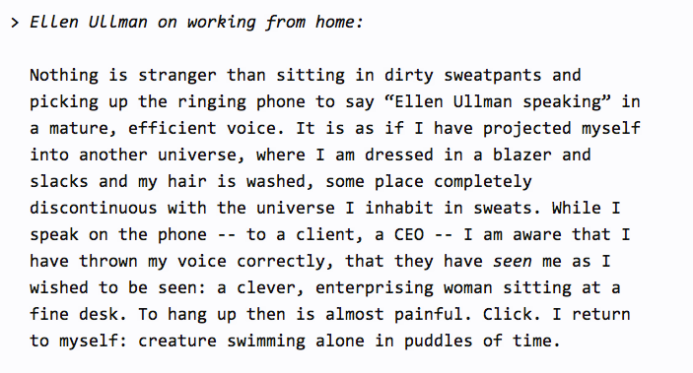Recently, we did an exercise within our team at TED … everyone had to write their own TED Talk. Why? To ensure we understand what we’re putting speakers through, and see if we couldn’t use this as a way to improve our own processes.
It was a pretty humbling experience. Put simply, I learned a *lot*, not least that TED Talks are incredibly hard to write. But I also learned a lot about the amazing group of people I work with.
Anyhow, I worked really hard on my talk, so I’m saving a version of it here.
I love order and structure. I really, really appreciate efficiency and clarity, while I never met a process I didn’t either love or secretly wish to redesign. When I was a kid, I taught myself to sew so I could sew my name into all of my clothes so that everyone would be clear that this was my ratty Donald Duck T-shirt. I find parties difficult because I am apparently congenitally incapable of being late so I end up having to walk around the block a few times before I go in so I’m not that person, who turns up when a host is still getting dressed or trying to find ice. I merrily, happily arrive hours early at the airport, while my secret dream is to find the time to write a book about musical notation systems, because I’m utterly obsessed with their beautiful order.
And then a few years ago, something happened that shattered my well appointed world and made me realize that, while order has its uses, it’s even more powerful when combined with a philosophy of openness. I learned, just as designers often learn, that a grid and a plan and a structure can provide an excellent, critically important, even beautiful foundation, but that creativity, color and richness come when you figure out what and how to layer on top of them.
So what was that thing? Well, his name is Jack. And first, I need to give you a little back story, to explain the grand plan that ended up spectacularly not coming off. Because the plan was that my gay friend Aaron would be my sperm donor and then he’d go his way and I would merrily single Mum my way. Only, that wasn’t how it worked out at all. And I promise you this isn’t that annoying story where I say with wide eyes that meeting my child caused me to instantly experience a love unlike any other blah blah. (To be clear, that’s totally true, but that’s not what this is about.)
When Jack was one day old, he died. His little tiny lungs failed, and after he was resuscitated he ended up hooked up to a machine the size of half this room, which pumped the blood out of his body, oxygenated it and then pumped it right back in again. This went on for nine excruciating days. But while he made a full recovery, I didn’t. This experience broke me open and into tiny pieces as my foundation and the basis for everything just … crumbled. When I went into the hospital, I’d had a plan. When I left it I had no plan at all … but the thing that held me together in some imperfect form was the realization that the only way to survive when everything crashes around you is to stay calm, keep breathing, and remain open to possibility.
And in my case, possibility had two names, that of Aaron and his husband Blake. Because, while their plan had been to be loving uncle type figures to this small baby, that didn’t become their reality either. Instead, the three of us bonded over fear, we broke open over the tiny body of our not-breathing child, and, when we finally left the hospital, we left as something none of us had planned for but were somehow all open to, a family.
Now we share the responsibilities of parenting. They moved a short walk away from us, and now our lives are just as intertwined and complicated as any more traditional family’s might be. We have family dinners, family outings, family vacations, sometimes even heated family discussions as we navigate our way through this unplanned new world. We have a shared calendar and a regular routine that forms the basis for what we’re building on top of it, which is the good bit, the family we never quite intended, but remained open to.
As I watch Jack grow, supported by the love of not one, not two, but three parents, I marvel at what we’re creating together and for him, with no plan, no road map, no real clue. I’m sure all new parents feel like no one else has ever experienced anything similar, but with our family, led by two gay married dads and one straight single mum, I feel like we’re pioneers, and it feels like it’s the combination of the deeply efficient and the searingly open that brings the magic.
Because, as you all know, I haven’t given up on my inner control freak. But this newfound conviction that the blend of the structured and the flexible are the way to go has helped me in other ways too, like learning to roll with the unexpected things that happen at live events — like, say, that time I got ambushed on the TED stage by a hologram. Arguably, swearing onstage wasn’t my finest professional moment, but I’m still somewhat proud that I rolled with this experience without completely freaking out. And actually, the fact that it happened freed me up to just go ahead and ask the tough questions of the hologram in the moment, questions that people afterwards told me they’d been wondering too.
It’s also what’s convinced me to give this talk today, rather than give the other, far less personal and arguably far easier talk about musical notation systems that I will still happily bore you about if you give me half a chance. But In being open with you, in sharing my story and even, yes, my vulnerabilities, I believe that I can be a better leader of this team, while still continuing to grow and learn myself.
Life is weird, and it’s complicated, and it’s messy, and therein lies its beauty. Now, I guess I understand that the combination of order and openness provides me with the best chance to experience it all. The other good news? Now, I am sometimes even genuinely late to parties. You’re welcome.


